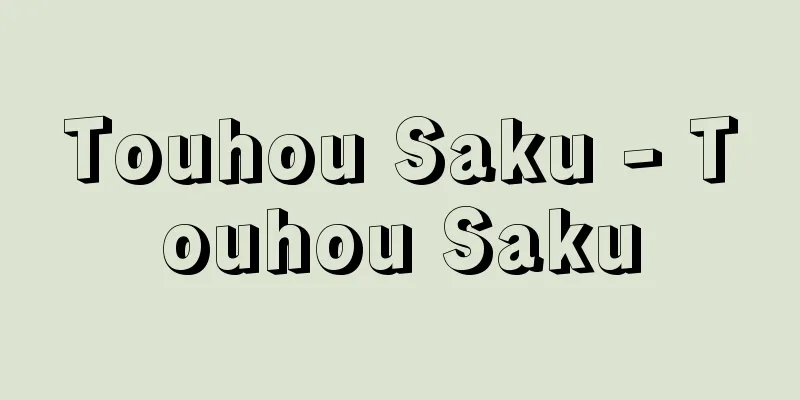Metal engraving

|
A type of metal craft, it is one of the most well-known metalworking techniques along with casting and hammering. It is a decorative technique that involves carving patterns or letters into the surface of metal with a chisel, creating openwork, or inlaying different metals, and has been widely used since ancient times for accessories, weapons, ritual equipment, furniture, and more. [Harada Kazutoshi] Techniques of engravingIn Japan, these techniques are generally divided into five types: line carving, openwork carving, high-profile carving, nanako, and inlay. (1) Line carving This is further divided into five types: dotted line carving, hair carving, kick carving, hoe carving, and katakiri carving. [1] Dotted Line Carving This is the most basic technique, in which lines are created by continuously striking the surface of the vessel with a pointed chisel. [2] Kebori: The most basic technique of line engraving. This technique is used to carve hair-thin lines using a sharp chisel with a triangular pyramid-shaped tip. It is often used for the inscriptions on the halo of Buddhist statues and the patterns on sutra boxes. Some of the more famous examples are the lotus petals on the pedestal of the Great Buddha of Todaiji Temple and the Hossouge Kebori sutra box at Enryakuji Temple. [3] Kikebori: This is a technique in which a chisel with a thin, flat tip is used to carve lines by striking the chisel with a kick while lifting the edge of the chisel. It is characterized by the fact that the carved marks are a series of wedge-shaped triangular dots. [4] Sukibori: A technique in which a thin, flat-tipped chisel is used to carve the pattern in a scraping motion. The pattern can be carved deeper into the periphery, or the base can be lowered one level to make the pattern stand out, creating a relief effect. [5] Katakiribori: A technique in which a chisel with a tip similar to that of a woodworking chisel is used to carve a line deep on one side and shallow on the other. This technique allows for an expression similar to the brush strokes used in painting. (2) Openwork: A technique in which a metal plate is cut open with a chisel or a jigsaw to create a pattern. There are two types of openwork: jisukuri, in which the base is open and the part to be the pattern is left open, and moyosukuri, in which the pattern is cut directly into the base. There are more examples of jisukuri, such as the gilt bronze openwork banner that was donated to the Horyuji Temple and the Fukukenjaku Kannon statue's crown in the Hokkedo Hall of Todaiji Temple. Openwork with patterns is often seen on the smoke holes of incense burners and sword tsuba. (3) Takanikibori: A technique for expressing a pattern in a three-dimensional way, higher than the surface of the vessel. There are two methods: one is to carve down the surface of the vessel except for the pattern, and the other is to carve the outline of the pattern by striking a metal plate from the back, and then carve the details from the front. In this case, a pattern with a thick surface is called takanikibori, and one with a thin surface is called usunikibori. A similar method is shishiaibori, in which the base plate around the pattern is carved down a little deeper, and the pattern is carved thinly, which has an effect similar to relief carving, but is characterized by the fact that the pattern does not rise higher than the base. (4) Gyoko This is a technique in which a thin, round chisel is struck on a metal surface to make it look like fine millet grains are sprinkled on the surface. It is so named because the dense adjacent strikes look like scattered fish eggs. It is often applied to the area surrounding the motif, and famous examples include the Ginshoko silver altar accessory at Todaiji Temple and the copper plate of the Thousand Buddhas and Tahoto Pagoda at Haseji Temple. (5) Inlay A technique in which the surface of a metal is scraped away and other metals are fitted into the recesses to create letters or patterns. Generally, gold or silver is inlaid into iron or copper inlays, allowing for color variations. There are a variety of techniques, including thread inlay, in which thin gold figures are fitted into engraved lines; flat inlay, in which a flat plate is fitted after a carving; high-profile inlay, in which a highly detailed carved piece is fitted; and cloth-grain inlay, in which cloth-grain-like notches are made on the surface of the inlay with a chisel, thin gold or silver wires or plates are placed on these and hammered from above with a hammer to blend in with the cloth grain. These various engraving techniques are more often combined than used alone. [Harada Kazutoshi] History of EngravingChina and KoreaIn China, from the Shang (Yin) and Zhou dynasties through to the Han dynasty (15th BC - 3rd century AD), so many excellent bronze vessels were produced using cast metal that it seems as if ancient engraving techniques were overshadowed, but bronze vessels from the Spring and Autumn period (770 BC - 403 BC) were often decorated on the surface with gold, silver and copper inlay, and the subsequent Warring States period (403 BC - 221 BC) saw many beautiful works with intricately delicate line inlay and flat inlay. Line engraving and hammering techniques were popular during the Tang dynasty (618 - 907), and in particular, 270 gold and silver vessels excavated from Hejiacun in Xi'an, Shaanxi Province, feature hair-carved and kick-carved designs of flowers, birds, animals and hunting motifs, as well as intricate fish roe. It is believed that a large amount of Tang dynasty metal engraving works were imported to Japan during the Nara period; in the Shosoin Repository there are a gold and silver flower plate with a large deer in the center and Chinese flower patterns carved into it, and a large silver jar with fish roe carved into the ground and hunting patterns carved into it, which had a great influence on the development of Japanese metal engraving techniques. The Korean peninsula also has a long history of metal engraving, with ornaments and horse equipment excavated from ancient tombs dating back to the 5th and 6th centuries (the Three Kingdoms period) featuring dotted line engraving, openwork and fine goldwork, and hair engraving and fish roe techniques already seen on relic vessels from the 7th and 8th centuries and on gilt-bronze scissors excavated from Anaptch. Inlay, also known as nyushi, was popular throughout the Goryeo period (936-1392), and many excellent examples of silver-line inlay remain on Buddhist altar implements such as water jars and incense burners. [Harada Kazutoshi] JapanIn Japan, there are remains of dotted line engraving from the Kofun period to the Asuka period (3rd to 7th centuries) (the outer circumference of the metal fittings of the honeysuckle arabesque openwork pendant ornament, a treasure donated to Horyu-ji Temple), and examples of kick engraving can be seen on helmets excavated from ancient tombs (the copper-wrapped plate of a helmet with a gilt bronze visor, excavated from the Otsukayama Kofun in Kisarazu City, Chiba Prefecture), and this technique was also used in mirror images that were popular during the Heian period (the mirror image of the Amida Triad Raigou at Kongosho-ji Temple in Mie Prefecture). After the Heian period, sukubori was also often used to decorate Buddhist altar implements (the Kongobanhosohanamon at the Tokyo National Museum), and eventually it was passed on to the production of sword tsuba during the Edo period. In the Edo period, sword fittings metalworker Yokoya Somin is said to have pioneered the Katakiribori technique, and in the Meiji period Kano Natsuo was renowned as a master of this technique. Nikuaibori, which is said to have been pioneered by Edo period sword fittings craftsman Sugiura Joi, is often seen on small items such as sword fittings such as kozuka and fuchigashira, tobacco pouches, and kiseru decorations. Thus, from the Kofun period to the Nara period, Japanese engraving techniques included dotted line engraving, hair engraving, kick engraving, openwork carving, thread inlay and fish roe, while in the Heian period, hoe carving, thin wall carving and flat inlay were added, and in the Kamakura period, high wall carving was also used. In the Edo period, with the rise of sword decoration metalwork in particular, single wall carving and wall carving were created, and at the same time, complex high wall carving and inlay were also developed, and it can be said that engraving techniques reached their peak. Furthermore, when the term "metal engraving" is used generally today, it does not necessarily refer to the original technique alone, but can also include a wide range of processing techniques, such as work using solder, processing with files, hammering, casting, and corrosion. [Harada Kazutoshi] WesternThe history of metal engraving is also long in the West, and as early as 2500 BC, the Sumerians of Mesopotamia and the Egyptians of the New Kingdom were already putting metals to practical use, polishing lapis lazuli and agate to create gorgeous ornaments that combined engraving with metal engraving. The most outstanding relics are the golden helmet and golden dagger of Meskalamdug, excavated at Ur, and the golden mask and throne of King Tutankhamun of Egypt (1300 BC). The Western world inherited this tradition of metal engraving, and as it progressed through the Greek and Roman eras, the Middle Ages, and the Renaissance, elegant engravings inlaid with precious stones were produced as furnishings for the royal and noble churches. Western engraving techniques can be broadly divided into stamping, which is the marking of metal plates with a chisel, engraving, which is the carving of lines with a chisel, inlaying, which is the carving of metal surfaces and inlaying other metals, filigree, which is the soldering of metal wires to surfaces, granule work, which is the soldering of metal grains, and openwork. In addition to these, there are actually various techniques such as enameling and the preparation for jewellery work, and the techniques of casting and hammering are often used together. Stamping is the same technique as Oriental takabuki carving, in which a soft base is placed under a metal plate and a chisel is used to stamp out lines and small patterns. Ancient Egyptians used this technique to create stamped reliefs and scarab amulet rings. Mediterranean civilizations, centered on Crete, also demonstrated their excellent engraving techniques in gold stamped plates and intaglio rings with motifs such as waves, fish, and wild flowers. Engraving is a technique in which a sharp, clear line is carved into the surface of a metal using a chisel called a burin to create a delicate decoration, and is a type of Oriental line engraving. The oldest example of engraving is the inscription on the "Bronze Door of Shalmaneser III" from the second half of the 9th century BC. Inlay is a technique in which grooves are made in iron or bronze with a chisel, and thin flakes or wires of gold, silver, copper, etc. are hammered into the iron to create a color effect. Excellent works have been produced in China and Japan since ancient times, but in Europe, it is also called Damascening, as it was learned from the iron inlay applied to Damascus weapons during the Renaissance. In Italy during the Renaissance, inlays of gold and silver on brass, copper, and bronze bullion became popular. Iron inlay spread from Venice to various parts of Europe in the 16th century, and was applied not only to weapons but also to furniture, picture frames, and small boxes. Arabesque patterns of Eastern origin were often used for inlay patterns, and the Moors of Spain were skilled in this technique. Toledo inlay is still famous today. Benvenuto Cellini, a famous metalworker of the Italian Renaissance, wrote in his autobiography that he himself was an expert in this technique. Among the inlay techniques, niello inlay, in which a mixture of copper, silver, lead, sulfur, and borax called niello is melted and polished into the engraved parts to make the engraved designs easier to see, has been practiced since ancient times. The oldest examples of niello inlay include the ceremonial axe (18th Dynasty) excavated from Thebes in ancient Egypt and the dagger excavated from a tomb in Mycenae discovered by Schliemann. Filigree, introduced from Western Asia during the Greek period, is the most frequently used decorative technique throughout the history of metalworking. The word filigree comes from the Latin word filum (wire) and refers to the bending and soldering of gold or silver wire into a spiral or coiled shape. Granulation, on the other hand, involves soldering tiny beads of gold or silver to metal surfaces. Both techniques were used to create shadows and a sense of volume on metal surfaces and were the foremost skill of the ancient Etruscans. Filigree and granulation were also used extensively in the Middle Ages and Baroque. In particular, monastic workshops in Germany competed with each other to produce liturgical vessels of a high technical and artistic standard. The binding of the Gospels made by the workshop of St. Michael's Cathedral in Hildesheim is made of gold and silver filigree and ivory and is a masterpiece of this period, along with the processional cross. After the Renaissance, the combination of engraving with cloisonné or jewels became commonplace, and in France it is divided into bijou (engraving without jewels) and joaillerie (jewelry, accessories with jewels as the main focus). Currently, international engraving design contests are often held in New York, Munich, and other cities. [Masaaki Maeda] "Illustrated Encyclopedia of Western Antiques" by Tsuneo Yumizu (1979, Graphic-sha Publishing) [Reference] | |Source: Shogakukan Encyclopedia Nipponica About Encyclopedia Nipponica Information | Legend |
|
金属工芸の一種で、鋳金(ちゅうきん)、鍛金(たんきん)とともに代表的な金工技法。金属の表面に鏨(たがね)を用いて文様や文字を彫ったり、透かしたり、別種の金属をはめ込むなどの加飾技法で、古くから装身具、武具、祭祀(さいし)具、家具などに広く用いられてきた。 [原田一敏] 彫金の技法日本ではその技法を、通常、線彫り、透(すかし)彫り、高肉(たかにく)彫り、魚々子(ななこ)、象眼(ぞうがん)の5種に大別している。 (1)線彫り これはさらに、点線彫り、毛彫り、蹴(けり)彫り、鋤(すき)彫り、片切(かたきり)彫り、の五つに細分される。 〔1〕点線彫り もっとも初歩的な技法で、先のとがった「はりいし鏨」で器面に連続的に打点して線条を表す。 〔2〕毛彫り 線彫りのもっとも基本的な技法。刃先が三角錐(さんかくすい)形にとがった「しぶ鏨」を使って毛のように細い線を彫るもので、仏像の光背銘や経箱の文様などにも多用され、東大寺大仏の台座蓮弁(れんべん)、延暦(えんりゃく)寺の宝相華(ほっそうげ)毛彫経箱などが著名である。 〔3〕蹴彫り 先端が薄く扁平な「ひら鏨」を用い、角を浮かせながら蹴るように打ち当てて線刻する技法。彫りあとが楔(くさび)形をした三角形の点の連続となるところに特徴がある。 〔4〕鋤彫り 先が平らな薄刃の「すき鏨」を使って鋤ですき取るように彫る技法。文様の外周を深みをつけて彫り込んだり、地を一段下げて文様を浮き立たせ、浮彫り風の効果を出すことができる。 〔5〕片切彫り 切っ先が木工の鑿(のみ)に似た鏨を用い、彫線の片方を深く、他方を浅く彫る技法。絵画の付立(つけたて)画法の筆勢に似た表現が可能である。 (2)透彫り 金属板を「きり鏨」や糸鋸(いとのこ)で切り透かして文様を表す技法。文様とする部分を残して地を透かす地(じ)透しと、地に直接文様を切り透かす文様透しとがあるが、地透しのほうが作例は多く、法隆寺献納宝物の金銅透彫灌頂幡(かんじょうばん)、東大寺法華(ほっけ)堂の不空羂索(ふくうけんじゃく)観音像宝冠などがよく知られ、文様透しは香炉の煙出し孔や刀の鐔(つば)などに多い。 (3)高肉彫り 文様を器面より高く立体的に表現する技法。文様部以外の器面を彫り下げる方法と、金属板を裏から打ち出して文様の概要を出したあと、表から細部を彫刻する方法の2種がある。この場合、文様の肉取りの厚いものが高肉彫りで、薄いものは薄肉彫りという。これに似た手法として肉合(ししあい)彫りがあるが、これは文様の周囲の地板を少し深く彫り下げ、文様部を薄肉彫りとするもので、浮彫りに似た効果があるが、文様が地より高くならないところに特徴がある。 (4)魚々子 先が細く小円となった鏨を金属面に打ち付け、表面に細かい粟(あわ)粒をまいたようにみせる技法。隣接して密に打たれたさまが魚卵をまき散らしたようにみえるところからこの名がある。文様の周囲の地に施されることが多く、著名な作例には東大寺の鎮壇具銀小壺(ぎんしょうこ)、長谷(はせ)寺の千仏多宝塔銅板などがある。 (5)象眼 金属の表面を削り取り、その凹部に他の金属をはめ込んで文字や文様を表す技法。一般に鉄や銅の地金に金や銀を象眼することが多く、色彩的変化を加えることができる。技法も多様で、刻線に細い金象をはめる糸象眼、彫り抜いたあとへ平板をはめる平象眼、高肉彫りされたものをはめる高肉象眼、地金の表面に布目状の刻み目を鏨でつけ、ここに金や銀の細線や薄板をのせて上から槌(つち)でたたき、布目になじませる布目(ぬのめ)象眼などがある。 これら種々の彫金技法は単独で用いられるよりも、何種類かが組み合わされる場合が多い。 [原田一敏] 彫金の歴史中国・朝鮮中国では商(殷(いん))・周から漢時代にかけて(前15~後3世紀)優れた鋳金による青銅器があまりにも多く制作されたため、古代の彫金技術はその陰に隠れた感があるが、春秋時代(前770~前403)の青銅器には表面に金・銀・銅の象眼による加飾がよく行われ、続く戦国時代(前403~前221)には複雑繊細な線象眼や平象眼を施した美しい作品が多くみられる。線彫りや打出し技法が盛行するのは唐代(618~907)で、とくに陝西(せんせい)省西安(せいあん)の何家村から出土した270点もの金・銀器には、毛彫り、蹴彫りによる草花、鳥、動物、狩猟文などの文様のほか、微細な魚々子が打たれたものがある。唐の彫金作品は奈良時代に日本にもかなり舶載されたと推定され、正倉院には中央の大きな鹿(しか)を打ち出し、周囲に唐花(からはな)文を蹴彫りした金銀花盤、地に魚々子を打って狩猟文を毛彫りした大銀壺があり、日本の彫金技術の発達に大きな影響を与えた。 朝鮮半島での彫金の歴史も古く、5~6世紀(三国時代)の古墳から出土した装身具・馬具には点線彫り、透彫り、細金細工が行われており、毛彫りや魚々子の技術も7~8世紀の舎利容器や、雁鴨池(アナプチ)出土の金銅鋏(はさみ)にすでにみられる。象眼は入糸(にゅうし)ともいい、高麗(こうらい)時代(936~1392)を通じて盛んに行われ、水瓶(すいびょう)や香炉などの仏具に銀線象眼の優品が多数現存している。 [原田一敏] 日本日本では、古墳時代から飛鳥(あすか)時代にかけて(3~7世紀)点線彫りの遺例があり(法隆寺献納宝物の忍冬(にんどう)唐草透彫垂飾(すいしょく)金具の外周)、古墳出土の冑(かぶと)には蹴彫りの例(千葉県木更津(きさらづ)市大塚山古墳出土の金銅眉庇(まびさし)付冑の銅巻板)がみられ、この技法は平安時代に盛行した鏡像にも用いられている(三重・金剛證寺の阿弥陀(あみだ)三尊来迎(らいごう)図鏡像)。平安時代以降は仏具の文様加飾に鋤彫りもよく行われ(東京国立博物館の金剛盤宝相華文)、やがて江戸時代には刀剣の鐔の制作へと引き継がれた。また江戸時代には装剣金工の横谷宗珉(よこやそうみん)が片切彫りを創始したと伝え、明治の加納夏雄(かのうなつお)はこの技法の名手として名高い。江戸期の装剣金工家杉浦乗意(じょうい)の創始とされる肉合彫りは、小柄(こづか)や縁頭(ふちがしら)などの装剣金具、たばこ入れ、きせるの装飾など小品に多くみられる。 このように日本の彫金技術は、古墳時代から奈良時代までは点線彫り、毛彫り、蹴彫り、透彫り、糸象眼、魚々子が行われ、平安時代には鋤彫り、薄肉彫り、平象眼が加わり、鎌倉時代には高肉彫りも用いられ、江戸時代に至ってとくに装剣金工の隆盛に伴い、片切彫り、肉合彫りが創始され、同時に複雑な高肉彫りや象眼も開発されて彫金技術は頂点に達したといえる。 なお、今日一般的に「彫金」という場合、かならずしも本来の技法のみに限定せず、鑞(ろう)付けによる細工や、鑢(やすり)を用いての加工、打出し、鋳金、腐食などの加工技法全般を含めることもある。 [原田一敏] 西洋西洋でも彫金の歴史は古く、すでに紀元前2500年代にメソポタミアのシュメール人や新王国時代のエジプト人らは金属を巧みに実用化し、ラピスラズリやめのうを研磨して、彫金と組み合わせた華麗な装身具をつくっている。ウル出土のメスカラムドゥッグの黄金の兜(かぶと)や黄金の短剣、あるいはエジプトのツタンカーメン王(前1300年代)の黄金のマスクや玉座はそのもっとも優れた遺品である。これらの彫金の伝統を受け継いだ西洋の世界では、ギリシア・ローマ時代、これに続く中世、さらにルネサンス期へと進むにつれて、王侯貴顕教会の什器(じゅうき)として貴石を象眼した優美な彫金が制作された。 西洋の彫金の技法には、大きく分けて、鏨(たがね)で金属板に刻印するスタンピングstamping、のみを使って線刻するエングレービングengraving、金属表面を刻み他の金属をはめ込む象眼inlaying、金属線を表面に鑞付けするフィリグリーfiligree(細線細工)、金属粒を鑞付けする粒金(りゅうきん)細工、それに透(すかし)彫りなどがある。このほか実際にはエナメリングenameling(七宝(しっぽう))や、宝石細工をする準備段階としてのさまざまな技法があり、さらに鋳金、鍛金の技法が互いに併用されていることが多い。 スタンピングは、東洋の高肉彫りと同じ打出技法で、金属板の下に柔らかい台を当て、押型用の鏨を使って線や小さな紋を打ち出していくもので、古代エジプト人はこの技法で打出しのレリーフやスカラベの御守(おまも)りの指輪などをつくった。またクレタを中心とした地中海文明では、波や魚、野の花といったモチーフで金の打出板や陰刻の指輪などに、彫刻の優れた技術を示した。 エングレービングは、ビュランとよばれるのみを使って金属の表から鋭く明確な線を刻んで繊細な装飾を施す技法で、東洋の線彫りがこれにあたる。エングレービングのもっとも古いものとしては、前9世紀後半の「シャルマネセル3世の青銅扉」に彫られた銘文がある。 象眼は、鉄や青銅の素地にのみで溝をつくり、金、銀、銅などの薄片や細線をハンマーで打ち込んで色の効果を出す技法で、中国や日本で古くから優れた作品が制作されたが、ヨーロッパではルネサンス時代にダマスカスの武器に施された鉄の象眼から学んだので、ダマスク細工Damasceningともよばれる。ルネサンス期のイタリアでは真鍮(しんちゅう)や銅、青銅の地金に金銀の象眼を施したものが流行した。鉄への象眼は16世紀にベネチアからヨーロッパ各地へ広まり、武器ばかりでなく、家具、額縁、小箱類にも応用された。象眼の文様は東方起源のアラベスク文様が多く使われ、スペインのムーア人が得意とした。現在でもトレドの象眼は有名である。イタリア・ルネサンス期の著名な金工師ベンベヌート・チェッリーニはその自伝のなかで、彼自身この象眼の技術に熟達していることを述べている。 象眼のなかでも、彫り出された図案を見やすくするために、彫った部分に黒金(ニエロ)という銅・銀・鉛・硫黄(いおう)・ホウ砂の混合末を溶かし込んで磨くニエロ象眼は古くから行われた。ニエロ象眼のもっとも古い例としては、古代エジプトのテーベ出土の儀式用斧(おの)(第18王朝)、シュリーマンが発見したミケーネの墳墓出土の短剣などがある。 細線細工(フィリグリー)は、ギリシア時代に西アジアから伝わり、彫金の歴史を通してもっとも頻繁に使われた装飾技法である。フィリグリーはラテン語のfilum(針金)に由来し、金や銀の針金を螺旋(らせん)状や巻き上げ状に曲げて鑞付けする。また粒金細工は、金や銀の極小の粒を鑞付けするもので、ともに金属面に陰影や量感を出すのに用いられ、古代エトルリア人のもっとも得意とした技法であった。細線細工や粒金細工は中世やバロック時代にも盛んに用いられた。とくにドイツの修道院の工房は、互いに競い合って技術的にも芸術的にも高い水準の典礼用の器物をつくった。ヒルデスハイムの聖ミカエル聖堂の工房でつくられた福音(ふくいん)書の装丁は金銀の細線細工と象牙(ぞうげ)によるもので、行列用十字架とともにこの時代の傑作である。 ルネサンス以後は彫金と七宝、あるいは宝石との組合せが常識となり、フランスではビジューbijou(宝石を使わない彫金)とジョアエリリjoaillerie(=ジュエリー、宝石を主とした装身具)に分けている。現在はニューヨーク、ミュンヘンなどで国際的な彫金のデザインコンテストがしばしば開かれている。 [前田正明] 『由水常雄著『図説西洋骨董百科』(1979・グラフィック社)』 [参照項目] | |出典 小学館 日本大百科全書(ニッポニカ)日本大百科全書(ニッポニカ)について 情報 | 凡例 |
Recommend
Ludwik
... The formation of the Sejm can be considered t...
Mukoroji - Mukoroji
A deciduous tall tree of the Sapindaceae family (...
Enciclopedia Italiana (English)
…In addition to gaining the consent of the people...
panelinha
...In other words, local politicians used campaig...
Safety education - Anzenkyoiku
A general term for the instruction and physical t...
Cryptophyceae
…The cell contains a nucleus and a membranous pla...
Kawasoe [town] - Kawasoe
An old town on the north shore of the Ariake Sea i...
Divided Nation - Bundankokka
This refers to countries whose borders have been d...
Sunni - Sunnah is
One of the two major Islamic sects, alongside Shii...
Upper Landesgericht
… [In Europe and the US] A three-tiered court sys...
Lozère (English spelling)
…Total length is about 375 km. It originates at L...
A playful essay
Southern Chinese drama. Also known as Nanqu. North...
Primeval forest
A primeval forest is a forest that has never been...
Smoke fan - Ento
...However, it is thought that the term "enb...
Song Ben Hai (English spelling)
A river in central Vietnam. It originates in the A...






![Oigawa [town] - Oigawa](/upload/images/67cb133ee187f.webp)


